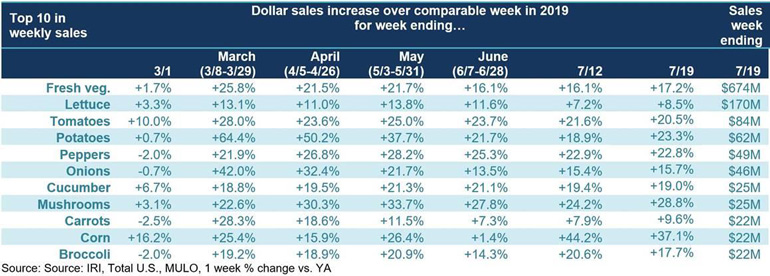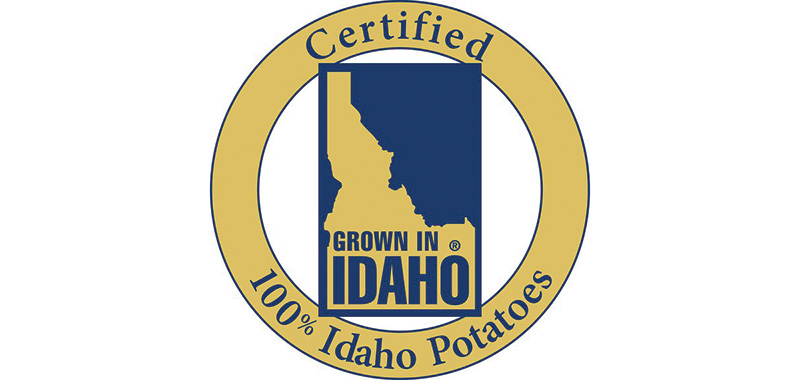The Idaho Potato Commission (IPC) has released their industry situation report for July 30, 2020.
Retail Sales:
Retail sales remain strong, up 23% versus last year in the week ending 7/19. Potatoes USA reported that volume was up 32% since the beginning of March and while that has slowed, it remains well above last year every week since Covid began.
Food Service:
As of Monday, July 13th, California is immediately shutting down restaurant dining rooms statewide in a bid to slow runaway growth in the state’s COVID-19 cases, Gov. Gavin Newsom announced in a tweet on Monday.
Brewpubs, bars, pubs and breweries have been directed to cease all operations, including takeout and delivery.
Full-fledged restaurants—places that generate the bulk of their revenues from food sales—can continue to offer takeout, delivery and outdoor dining, the announcement indicated. The exceptions are places in Alameda County, where a change in state safety standards forced all restaurant service to be halted. Newsom did not say how long the second shutdown might last.
He had suspended on-site service within 19 counties accounting for 70% of the state’s population on July 1, right before the 4th of July holiday weekend.
As of 7/30/2020 – California Pizza Kitchen has declared bankruptcy.
KFC is working hard to win the love of fans of its former potato wedges over to its newly launched Secret Recipe fries. In order to do that, KFC has priced the new fries at 30 cents an order for Monday’s Hallmark holiday, with any other purchase. That’s about how much Americans paid for French fries in those frizzed-out hair days of 1970 and a value that will likely get more than a few to sample the new thinner coated fries. Already, KFC said customers are gobbling up about 12% more meals with fries than they previously did with the thicker, less crispy wedges so many professed to loving across social media when the switch was announced.
Following the initial closure of indoor businesses operations in 30 counties earlier in July, California is now expanding the shutdown of indoor dining at restaurants and wineries to all 58 California counties. The order also includes a complete shutdown of all bars.
Gov. Gavin Newsom made the announcement on July 13 as the state fights a surge of coronavirus cases and hospitalizations that have been steadily increasing since June. California has reported an average of 8,000 new cases daily, according to data from The New York Times.
The 30 counties on the state’s watch list where new COVID-19 cases have hit dire levels — including Alameda County, Los Angeles County, Orange County, and San Diego County — are also being ordered to close shopping malls, gyms, churches, barbershops and salons. In total, more than 80% of California’s population lives in the 30 counties on California COVID-19 watch list, according to ABC News.
Sixty percent of the more than 26,000 restaurants that were temporarily shuttered by the pandemic will not reopen, according to the Yelp Economic Average quarterly report released July 22. It found that nearly 16,000 restaurants have shut down permanently, an indication that for many restaurant businesses, even shifts to delivery- and carryout-only operations have been unsuccessful.
The findings mean that the restaurant industry leads the nation in its number of business closures, even more than retail in general, according to Yelp, which said that since mid-June, restaurant permanent closures nationally have grown 23%.
McDonald’s Corp. reported a 68% drop in net income for the second quarter ended June 30, the first quarter to show the full impact of the coronavirus pandemic.
U.S. same-store sales decreased 8.7% for the second quarter ended June 30. Results sequentially improved each month throughout the quarter. In June, comps were down 2.3%.
– Average checks remained strong.
– Global same-store sales declined 23.9%.
– Nearly all McDonald’s restaurants around the world are open.
Net income of $483.8 million was down from $1.52 billion for the same quarter, last year. Most of that is driven by declines in comp sales during the quarter, in addition to one-time expenses such as $200 million in marketing support to help franchisees during the pandemic.
International:
The International team continues to have zoom call shipper meetings with all shippers interested in export activities. The IPC is applying for a Specialty Crop Block Grant to increase Idaho Dehydrated potato exports to the UK. International business customers are excited for Idaho’s new potato crop in a couple months.
Industry Relations:
Food Box Update-
USDA announced on Friday July 24th a third round of purchases for the Farmers to Families Food Box Program. This will invest another $500-$700 million into this program. This program will extend through the end of October 2020.
CFAP Update-
County FSA offices are accepting applications for those with shipments affected by COVID-19 until Friday August 28th, 2020. With harvest coming up fast, we urge all growers to contact their county offices. For contacts to FSA offices, follow this link. https://www.farmers.gov/coronavirus/service-center-status
This program allows for $16 billion in funds appropriated for payments. As of right now, they have authorized $6.5 billion of the $16 billion in payments for over 470,000 applications throughout the United States. Idaho has had 3,657 payments approved for about $130 million. https://www.farmers.gov/cfap/data
Regarding possible future audits of CFAP funds, please direct your attention to this link and pages https://www.fsa.usda.gov/Internet/FSA_File/1-cfap_r00_a01.pdf. See pages 1-11 through 1-12 for producer responsibilities.
A common question that is asked is how the USDA determined the dates of January 15 to April 15th. This questions is covered in the FAQ(frequently asked questions) section of the website.
As per the USDA, “CFAP assists producers of agricultural commodities who have suffered a 5-percent-or-greater price decline due to COVID-19 from January 15 to April 15 and face additional significant marketing costs for held inventories after that period as established in the CFAP regulation. The large majority of losses covered under the CARES portion of the CFAP rule considers one quarter of production that occurred in the beginning of 2020 that was significantly affected by COVID-19. USDA chose January 15 as the start date for the first quarter calculation as it represents market conditions prior to COVID-19 arrival in the United States. April 15 was chosen as the ending date as it represents the end of the three-month period (or one quarter) beginning on January 15 (the middle of the week used for the beginning period of prices). In addition, USDA waited as long as possible to update price data to capture as much of the COVID-19 impacts as possible before submitting the rule package for approval. Price comparisons were completed using average prices for the week of April 6-10, the last week immediately prior to April 15. Assistance for additional significant marketing costs for held inventories of livestock begins on April 16 and ends on May 14 to capture the period after the first quarter but before publication of the CFAP regulation”.
We understand that the bottom of the market for potatoes was in May and not April 15th. Growers that sold their potatoes at the bottom of the market are currently not eligible for these payments. We are trying to educate the USDA on this for possible adjustments.


